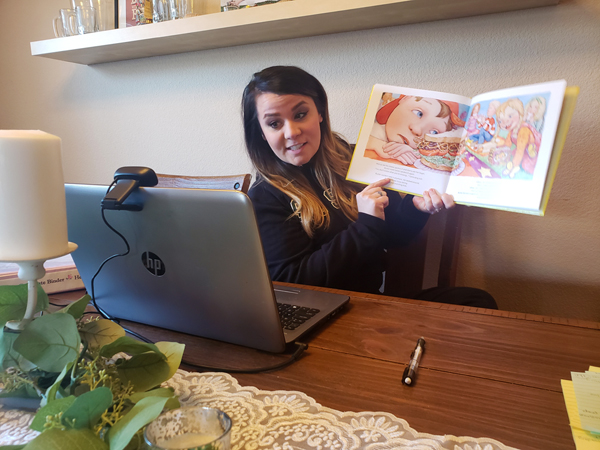 Heather Heaton was one of several Sacramento State teaching credential students who created and delivered lessons to K-12 students via the Sac State Web Academy. (Photo courtesy of Heather Heaton)
Heather Heaton was one of several Sacramento State teaching credential students who created and delivered lessons to K-12 students via the Sac State Web Academy. (Photo courtesy of Heather Heaton)
By Jonathan Morales
Kathryn Ivory was just a few weeks from completing her student teaching in West Sacramento and earning her credential when the COVID-19 pandemic hit, shutting down schools across the nation.
Ivory and other Sacramento State credential candidates suddenly faced a major problem: How could they complete the state-mandated student-teaching hours without a classroom?
The answer emerged when the College of Education stepped in with the Sacramento State Web Academy (SacStateWAC), an online platform through which students could plan, upload, teach, and assess lessons, ensuring they wouldn’t fall behind on their hours.
“I really appreciated how quickly the teaching credential program reacted when schools closed,” Ivory said. “They set this thing up so fast, and I know it eased a lot of the confusion and stress about completing student teaching hours.”
Planned and launched in just over a week following the closures, SacStateWAC ultimately featured 122 online lessons produced and taught by Sacramento State students. It logged a high of 583 daily users, a number that decreased later in the semester as K-12 schools began distance learning. The lessons were designed to supplement, not replace, K-12 students’ regular curriculum.
Students who participated say that, though virtual teaching isn’t ideal, the experience was valuable and helped them gain crucial new skills as well as finish their credentials. Professor of Education Chia-Jung Chung, who was largely responsible for planning and implementing SacStateWAC, said the work from Sac State students exceeded her expectations for how many lessons were produced and how good the work was at a difficult time.
"They really went above and beyond just doing this for their requirements,” she said. “They really acted like teachers, applying their knowledge and skills into real and effective teaching for students in our community."
Chung teaches the credential program’s required educational technology course, which has taken on added importance as the immediate future of K-12 schools remains in limbo. Many of the districts in which Sacramento State graduates will teach this fall are still deciding whether to return in person, continue distance learning, or attempt a hybrid of the two.
"It's very important for candidates, before they start teaching in the classroom, to think about how the use of technology will affect kids' learning or improve their learning,” she said. “The key is, our candidates are confident in their decisions. They know when, how and what to use in decision making for their classrooms."
Recent multiple-subject credential graduate Amanda Borges said when online teaching suddenly went from an abstract concept to a reality, she appreciated the skills and tools she learned in the educational technology class.
Borges created five fifth-grade lessons for SacStateWAC, some of them adapted from her previous student-teaching, in subjects ranging from math to social science to visual and performing arts. Like other students, she had to get creative, knowing she wouldn’t be able to interact directly with her class. For example, she modeled her lesson about the lost colony of Roanoke on “crime scene investigation,” and asked students to look for clues to discover what happened to the colonists.
“I wanted to make sure the lessons were still fun and enjoyable, since I know online it can be boring looking at a computer screen listening to a teacher talk,” she said.
One benefit of the academy was it allowed credential students to expand beyond their existing student-teaching placement. Jonathan Goold had been teaching fourth-graders in West Sacramento. Through SacStateWAC, he was able to create lessons for first- through sixth-graders.
“It was one of those situations where you're going to get out of it what you put into it, so I used the opportunity to get the most out of my experience at Sac State,” Goold said. “Even though the semester ended with distance learning, I feel I still got the full Sac State teaching credential experience.”
Beyond helping Sacramento State students, SacStateWAC also helped current K-12 teachers by providing resources about how to develop effective online lessons, Chung said. It’s unclear if the academy will continue now that the immediate need sparked by sudden school closures has passed, she said, but it will become a valuable example for future credential candidates about adapting to changing situations and ensuring learning still happens.
Ivory will begin her teaching career in her hometown of Winters this fall and remains unsure if she’ll do so in a physical classroom or online. Whatever the situation, she said she feels ready.
“Obviously, the school closures were devastating for all teachers and teacher candidates trying to get our placement hours," she said. "However, I think it was a great opportunity to build up skills of using online teaching tools.
“This was a great time to practice that, and I feel more prepared to use tech in my classroom, whether that classroom be in a physical space or online.”
